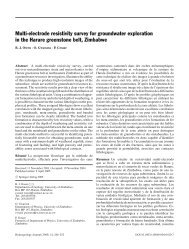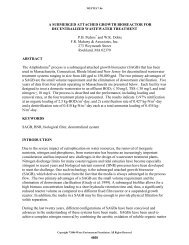Species diversity in the Florida Everglades, USA - Environmental ...
Species diversity in the Florida Everglades, USA - Environmental ...
Species diversity in the Florida Everglades, USA - Environmental ...
Create successful ePaper yourself
Turn your PDF publications into a flip-book with our unique Google optimized e-Paper software.
258 M. T. Brown et al. Ecosystem bio<strong>diversity</strong> <strong>in</strong> <strong>the</strong> <strong>Florida</strong> <strong>Everglades</strong><br />
ENP, <strong>the</strong> majority (664) are dicotyledons, with 316<br />
monocotyledons; over 45 ferns (and fern allies) have also<br />
been cataloged (Avery and Loope, 1983). While <strong>the</strong> plant<br />
<strong>diversity</strong> of <strong>Everglades</strong> is large, it is distributed unevenly<br />
<strong>in</strong> space. The diverse ecosystem mosaic (at both landscape<br />
and regional scales) leads to high β-<strong>diversity</strong><br />
(Whittaker, 1975) even where α-<strong>diversity</strong> may be low <strong>in</strong><br />
many of <strong>the</strong> particular patches.<br />
Table 1. Targeted <strong>Species</strong> <strong>in</strong> <strong>the</strong> CERP’s South <strong>Florida</strong> Multi-<strong>Species</strong> Recovery Plan (MSRP).<br />
Status <strong>Species</strong> Scientifi c name<br />
Much of <strong>the</strong> plant life (>60 %) <strong>in</strong> <strong>the</strong> South <strong>Florida</strong><br />
ecosystem is of tropical affi nity, and local endemism rates<br />
are high (65 taxa are endemic, mostly concentrated <strong>in</strong> <strong>the</strong><br />
rocky p<strong>in</strong>elands on <strong>the</strong> eastern <strong>Everglades</strong>) (Long and<br />
Lakela, 1976). Most of <strong>the</strong> communities found <strong>in</strong> <strong>the</strong> region<br />
are unique to North America, with closer analogs<br />
throughout <strong>the</strong> Caribbean, and many of <strong>the</strong> tropical species<br />
found are at <strong>the</strong> northward extent of <strong>the</strong>ir habitat range.<br />
Mammals<br />
E Key deer Odocoileus virg<strong>in</strong>ianus clavium<br />
E Key Largo cotton mouse Peromyscus gossyp<strong>in</strong>us allapaticola<br />
E<br />
Birds<br />
Key Largo woodrat Neotoma fl oridana smalli<br />
T Audubon‘s crested caracara Polyborus plancus audubonii<br />
E Cape Sable seaside sparrow Ammodramus (= Ammospiza) maritimus mirabilis<br />
E Snail kite Rostrhamus sociabilis plumbeus<br />
E<br />
Reptiles<br />
<strong>Florida</strong> grasshopper sparrow Ammodramus savannarum fl oridanus<br />
E American crocodile Crocodylus acutus<br />
T Bluetail (blue-tailed) mole sk<strong>in</strong>k Eumeces egregius lividus<br />
T<br />
Invertebrates<br />
Sand sk<strong>in</strong>k Neoseps reynoldsi<br />
E Schaus swallowtail butterfl y Heraclides (= Papilio) aristodemus ponceanus<br />
T<br />
Plants<br />
Stock Island tree snail Orthalicus reses<br />
E Avon Park harebells Crotalaria avonensis<br />
E Beach jacquemontia Jacquemontia recl<strong>in</strong>ata<br />
E Beautiful pawpaw Deer<strong>in</strong>gothamnus pulchellus<br />
E Carter‘s mustard Warea carteri<br />
E Crenulate lead-plant Amorpha crenulata<br />
E Deltoid spurge Chamaesyce (= Euphorbia) deltoidea<br />
E <strong>Florida</strong> perforate cladonia Cladonia perforata<br />
E <strong>Florida</strong> ziziphus Ziziphus celata<br />
E Four-petal pawpaw Asim<strong>in</strong>a tetramera<br />
E Fragrant prickly-apple Cereus eriophorus var. fragrans<br />
T Garber’s spurge Chamaesyce (= Euphorbia) garberi<br />
E Garrett’s m<strong>in</strong>t Dicerandra christmanii<br />
E Highlands scrub hypericum Hypericum cumulicola<br />
E Key tree-cactus Pilosocereus (= Cereus) rob<strong>in</strong>ii<br />
E Lakela’s m<strong>in</strong>t Dicerandra immaculata<br />
E Lewton’s polygala Polygala lewtonii<br />
E Okeechobee gourd Cucurbita okeechobeensis ssp. okeechobeensis<br />
T Papery whitlow-wort Paronychia chartacea (= Nyachia pulv<strong>in</strong>ata)<br />
T Pigeon w<strong>in</strong>gs Clitoria fragrans<br />
E Pygmy fr<strong>in</strong>ge-tree Chionanthus pygmaeus<br />
E Sandlace Polygonella myriophylla<br />
E Scrub blaz<strong>in</strong>g star Liatris ohl<strong>in</strong>gerae<br />
E Scrub m<strong>in</strong>t Dicerandra frutescens<br />
E Short-leaved rosemary Conrad<strong>in</strong>a brevifolia<br />
E Small’s milkpea Galactia smallii<br />
E Snakeroot Eryngium cuneifolium<br />
E T<strong>in</strong>y polygala Polygala smallii<br />
E Wireweed Polygonella basiramia (=ciliata var. b.)<br />
Source: “Notice of Availability of a Technical/Agency Draft Implementation<br />
Schedule for <strong>the</strong> South <strong>Florida</strong> Multi-<strong>Species</strong> Recovery Plan” [Federal Register:<br />
April 2, 2004 (Volume 69, Number 64)]
















